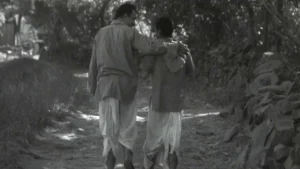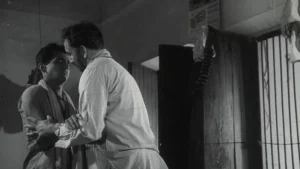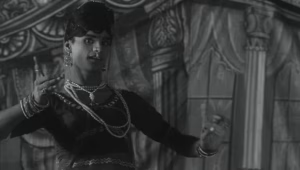A Forgotten Cinematic Gem Resurfaces: Rediscovering India’s First LGBTQ Film After Decades of Obscurity
In a remarkable turn of events, Badnam Basti—India’s first LGBTQ film—has emerged from near-total obscurity. Released in 1971 and directed by Prem Kapoor, the film disappeared shortly after a limited festival run. For nearly five decades, it was presumed lost. However, in 2019, curators Simran Bhalla and Michael Metzger, while conducting unrelated research in Berlin, stumbled upon a 35mm print of the film stored at the Arsenal Institute for Film and Video Art. The discovery shocked the global film preservation community, especially since no known copy existed in Indian archives.
The film adapts Kamleshwar’s novel Ek Sadak Sattavan Galiyan and portrays an emotionally intense love triangle involving a bandit named Sarnam, a temple worker Shivraj, and a young woman named Bansuri. What sets this apart is its nuanced portrayal of male intimacy—an audacious narrative for 1971 India. The film’s recovery holds enormous cultural significance, positioning Badnam Basti as not only a pioneering queer work but also a lost chapter in Indian cinematic history.
Also Read : “Raanjhanaa” AI Controversy: Aanand L. Rai, Dhanush, and Sonam Kapoor Object to AI-Generated Happy Ending

Painstakingly Restored and Preserved: How India’s First LGBTQ Film Was Brought Back to Life
After the film’s rediscovery, restoration experts quickly collaborated with India’s NFDC-NFAI, where the original negatives were eventually found. Arsenal’s subtitled version and the Indian negatives were merged to rebuild the film in its truest form. This restoration effort was not merely about salvaging celluloid but about preserving an erased narrative from Indian queer history.
The restored version of India’s first LGBTQ film is now visually and emotionally more impactful. Experts used digital restoration to correct sound, remove scratches, and restore colors to their original richness. This collaboration between institutions across continents exemplifies how global film preservation networks can come together to rescue historically marginalized narratives. Without the combined efforts of Berlin’s Arsenal, U.S.-based curators, and India’s National Film Archive, Badnam Basti might have remained lost forever.
IFFM 2025 to Showcase Badnam Basti at Its Pride Celebratory Night with Global Recognition
The Indian Film Festival of Melbourne (IFFM), one of the most prestigious platforms for Indian cinema abroad, has announced the restored Badnam Basti as a headliner for its Pride Celebratory Night. The screening will take place on August 22, as part of IFFM’s 16th edition, scheduled from August 14–24, 2025.
This year’s festival is set to screen over 75 films, representing voices from varied identities including gender, sexuality, race, disability, and class. IFFM Director Mitu Bhowmik Lange emphasized the importance of reclaiming space for queer stories in Indian cinema. “This Pride Night is not just about celebration,” she said, “it’s about acknowledging the stories that were denied space and visibility.”
By honoring Badnam Basti—India’s first LGBTQ film—IFFM places historical storytelling at the heart of contemporary queer visibility. The film will screen alongside Onir’s We Are Faheem and Karun, a modern queer romance, bridging generational gaps in LGBTQ representation.
A Cultural Milestone in Cinema: Why India’s First LGBTQ Film Remains Profoundly Relevant in 2025
Though released more than 50 years ago, Badnam Basti remains deeply relevant. As India’s first LGBTQ film, it bravely explored themes of identity, intimacy, and same-sex attraction during a time when homosexuality was criminalized under Section 377 of the Indian Penal Code. Its characters express longing and desire subtly—through gestures, glances, and poetic dialogue—yet powerfully.
In one memorable moment, the character Sarnam tells Shivraj, “I thirst for you,” a line that carries emotional weight and layered meaning. Though the Censor Board pressured the director to tone down explicit content, the film retains enough subtext to be unmistakably queer. It was a film far ahead of its time, and its reemergence challenges the idea that LGBTQ cinema in India began only in the 2000s.
Its screening now serves not just as nostalgic recovery but as a reminder that Indian queer identity has always had cultural expression, even when silenced or erased.
Celebrating Diversity Through Cinema: IFFM 2025 Focuses on Inclusivity and Representation
This year’s IFFM theme focuses on “Cinema as a Voice of Inclusion.” Along with showcasing India’s first LGBTQ film, the festival will also spotlight stories that speak to gender rights, neurodiversity, caste discrimination, and women’s empowerment. Notable events include retrospectives of Aamir Khan’s body of work and global recognition for comedian and actor Vir Das.
For the LGBTQ community, the inclusion of Badnam Basti underscores the ongoing evolution of Indian cinema. While today’s LGBTQ narratives are more visible, they owe much to foundational films like this one. Screenings will be accompanied by panel discussions, Q&As with restoration experts, and educational workshops to engage younger audiences unfamiliar with early queer representation.
A Legacy Reclaimed: From Obscurity to Global Acclaim
Badnam Basti was once considered a failure. It barely made noise at the box office, was rejected by commercial distributors, and was swiftly buried in history. But in 2025, the film finds itself at the center of global conversations on identity, censorship, and the erasure of queer stories.
Historians and cinema scholars are reevaluating its place in Indian film history. Far from being a forgotten experiment, it is now seen as the cornerstone of queer Indian cinema. Its rediscovery validates the lived experiences of queer people in India long before legal and social reforms recognized their rights. Through its screening at IFFM 2025, the film not only gets a second chance but reclaims its rightful legacy.

What This Means for the Future of Queer Indian Cinema
The journey of Badnam Basti, from being buried in archives to shining at IFFM 2025, is symbolic of larger societal shifts. As India’s first LGBTQ film, its revival encourages a reassessment of how we define progress in representation. It challenges newer filmmakers to explore queerness not just as identity, but as storytelling, style, and political resistance.
This is not just a film screening; it is a cultural event that links generations. It invites audiences to revisit where queer storytelling began and to reimagine where it can go next.
India’s first LGBTQ film, Badnam Basti, is more than just a cinematic milestone—it’s a reclaimed narrative. Its restoration and screening at IFFM 2025 serve as a powerful testament to resilience, historical truth, and the enduring power of queer storytelling. As global audiences revisit this pathbreaking work, they are reminded that the roots of LGBTQ cinema in India run deeper and farther back than previously acknowledged.
This celebration is not just about a film. It’s about visibility, validation, and the vibrant history that LGBTQ Indians have always had—onscreen and off.


